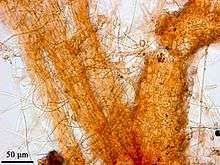Texas root rot
| Phymatotrichopsis omnivora | |
|---|---|
 | |
| Scientific classification | |
| Kingdom: | Fungi |
| Phylum: | Ascomycota |
| Class: | Pezizomycetes |
| Order: | Pezizales |
| Family: | Rhizinaceae |
| Genus: | Phymatotrichopsis |
| Species: | P. omnivora |
| Binomial name | |
| Phymatotrichopsis omnivora (Duggar) Hennebert, (1973) | |
| Synonyms | |
|
Grandiniella omnivora (Shear) Burds., (1977) | |
Texas root rot (also known as Phymatotrichopsis root rot, Phymatotrichum root rot, cotton root rot, or, in the older literature, Ozonium root rot) is a pathogen fairly common in Mexico and the southwestern United States that causes sudden wilt and death of affected plants, usually during the warmer months. It is a soil-borne fungus of the species Phymatotrichopsis omnivora that attacks the roots of susceptible plants. Because the damaged roots are unable to take up enough water to maintain the plant in warm weather, the leaves wilt and the plant dies. The dead leaves usually remain attached to the plant.
A multitude of dicotyledonous tree, shrub and herbaceous plants are susceptible to Texas root rot, including figs, pomegranates, elms, grapes, cotton, alfalfa, oleander, and roses. The largest compilation of hosts, more than 1,700, was made by J. Taubenhaus and W. Ezekiel.[1] It is one of the most destructive fungal plant diseases. Some monocot plants are tolerant and others are immune.
Eradication or control of Texas root rot is difficult, at best. The fungus is known to thrive in moist and alkaline soils. It can survive for long periods in the soil, sometimes lying dormant for decades, and can penetrate to depths of up to twelve feet. Increasing the organic content of the soil with compost and green manure may help to reduce growth of the fungus.
A monograph of this disease, which includes a historical review, was written by Streets and Bloss in 1973.[2]
References
- ↑ J.J. Taubenhaus and W.N. Ezekiel. 1936. A rating of plants with reference to their relative resistance or susceptibility to Phymatotrichum root rot. Texas Agric. Exp. Stn. Bull. 527
- ↑ R.B. Streets and H.E. Bloss. 1973. Phymatotrichum Root Rot. Monograph #8. The American Phytopathological Society, St. Paul, MN
External links
- Cotton (Texas) Root Rot
- Texas Root Rot
- Index Fungorum - Phymatotrichopsis omnivora
- USDA ARS Fungal Database
- EPPO Quarantine pest: Phymatotrichopsis omnivora
- Persoonia - Molecular Systematics of Phymatotrichopsis omnivora
- NC State Pathogen Profile